Scottish Crime and Justice Survey 2017/18: main findings
Main findings from the Scottish Crime and Justice Survey 2017-18 and the self-completion findings covering the period 2016-17 to 2017-18.
4. Focus on property crime
What was the extent and prevalence of property crime in 2017/18?
There were an estimated 430,000 property crimes in Scotland in 2017/18, representing just over 70% of all crime experienced by adults.
The Scottish Crime and Justice Survey estimates that 430,000 incidents[34] of property-related crime[35] were experienced by adults in Scotland in 2017/18. This represents 71% of all crime measured by the SCJS in 2017/18, the remainder being violent incidents.
As a sample survey of the general public, SCJS results are estimated values with margins of error, rather than exact counts of criminal incidents. Further information on the process used to calculate estimates is contained within the Technical Report. Taking into account confidence intervals, the SCJS estimates that there were between 384,000 and 476,000 incidents of property crime in Scotland in 2017/18. Analysis from this point onwards will focus on the best estimates for results across the survey for each sweep.
The amount of property crime experienced by adults in Scotland has fallen greatly since 2008/09, but shown no change since 2016/17.
Looking at trends over time, the SCJS finds that the number of property crime incidents has decreased markedly since 2008/09, as shown in Figure 4.1[36].
Figure 4.1: Estimated number of property crime incidents, 2008/09 - 2017/18
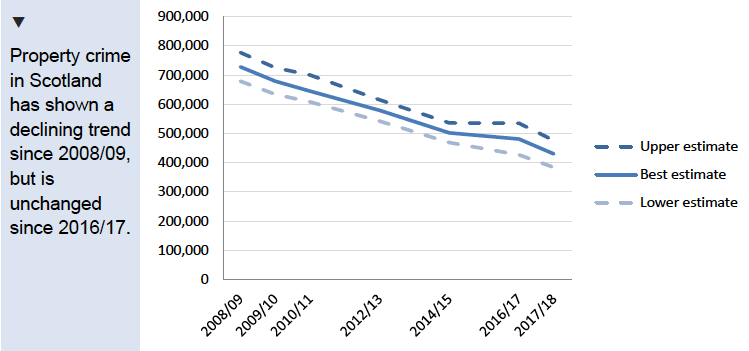
Base: SCJS 2008/09 (16,000); 2009/10 (16,040); 2010/11 (13,010); 2012/13 (12,050); 2014/15 (11,470); 2016/17 (5,570); 2017/18 (5,480) Variable: INCPROPERTY
Table 4.1 examines results from key comparator years[37] more closely and shows that the estimated number of incidents of property crime experienced by adults has:
- reduced by 41% since 2008/09, from 728,000 to 430,000. This decrease of almost 300,000 incidents is statistically significant.
- shown no change since the last SCJS in 2016/17 – the apparent decrease from 481,000 in 2016/17 is not statistically significant.
Table 4.1: Estimated of number of property crimes (2008/09, 2016/17, 2017/18)
| Crime type | 2008/09 | 2016/17 | 2017/18 | Change since 2008/09 | Change since 2016/17 |
|---|---|---|---|---|---|
| Best estimate | 728,000 | 481,000 | 430,000 | ↓ by 41% | No change |
| Lower estimate | 679,000 | 429,000 | 384,000 | ||
| Upper estimate | 777,000 | 534,000 | 476,000 | ||
| Number of respondents | 16,000 | 5,570 | 5,480 |
Variable: INCPROPERTY.
Whilst the SCJS has detected no change in the level of property crime since the last sweep, it does find evidence that it has continued to fall in recent years with a significant decrease of 14% detected between 2014/15 and 2017/18. This is in contrast to violent crime which has shown more stability over more recent years. Given that it is often more challenging to find significant changes between adjacent sweeps, this decrease over the last few years provides some indication that property crime has remained on a declining trend despite the lack of change detected since the 2016/17 SCJS.
The proportion of adults experiencing property crime has also fallen since 2008/09.
The SCJS results show that, as in previous years, most adults were not victims of any crime in 2017/18, with 10.8% experiencing property crime. Adults were more than four times as likely to have been victims of property crime as violent crime in 2017/18, which was experienced by 2.3% of the population.
As with incident numbers, crime prevalence rates are also estimates derived from a sample survey of the population with associated margins of error around them. Taking into account these confidence intervals, between 9.8% and 11.8% of the adult population were estimated to have experienced property crime in 2017/18, with 10.8% representing the best estimate[38]. Again, as with incident counts, analysis from this point onwards will focus on the best estimates for results across the survey for each sweep[39].
Looking at trends over time, the proportion of adults who were victims of property crime has fallen in the last decade from 18.0% in 2008/09 to 10.8% in 2017/18, as shown in Figure 4.2.
Although the SCJS detects no change in experiences of property crime since the last survey in 2016/17, the prevalence rate in 2017/18 was lower than the 2014/15 rate of 13.0% suggesting that there has been some reduction in victimisation in recent years as well as over the longer-term, mirroring the trend seen in the incident rate.
Figure 4.2: Proportion of adults experiencing property crime by year
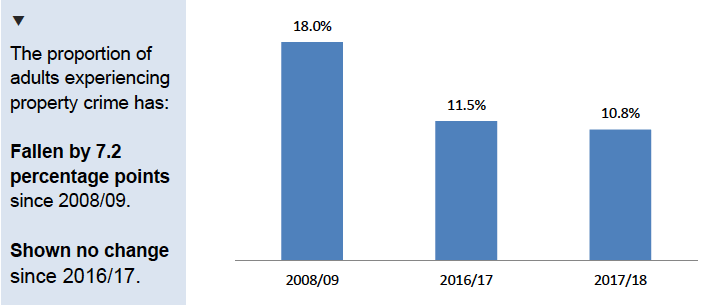
Base: SCJS 2008/09 (16,000); 2016/17 (5,570); 2017/18 (5,480) Variable: PREVPROPERTY
What types of property crime were most commonly experienced?
Vandalism continues to be the most common form of property crime experienced in Scotland, but has more than halved in volume since 2008/09.
As shown in Figure 4.3, a range of different types of property crime were experienced in Scotland in 2017/18. As in previous years, incidents of vandalism accounted for the largest proportion of property crime incidents (38%), followed by ‘other household theft (including bicycle theft)’ (29%) and ‘personal theft’ (22%)[40].
Figure 4.3: Categories of crime as proportions of property crime overall
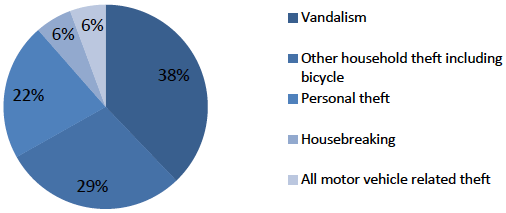
Base: SCJS 2017-18 (5,480). Variables: INCVAND, INCOTHERHOUSETHEFTCYCLE, INCALLMVTHEFT, INCHOUSEBREAK, INCPERSTHEFT.
There have been notable reductions in the number of incidents of vandalism, other household theft and motor vehicle related theft since 2008/09, as Table 4.2 below outlines. For example, the SCJS finds that the amount of vandalism in Scotland has more than halved since 2008/09, from an estimated 350,000 incidents to 163,000.
Since 2016/17, the estimated amount of motor vehicle related theft has fallen by just over a third, whilst all other categories of property crime have shown no change in the number of incidents over the short-term.
Table 4.2: Estimated number of incidents of types of property crime (2008/09, 2016/17, 2017/18)
| Crime type | 2008/09 | 2016/17 | 2017/18 | Change since 2008/09 | Change since 2016/17 |
|---|---|---|---|---|---|
| Property Crime | 728,000 | 481,000 | 430,000 | ↓ by 41% | No change |
| Vandalism | 350,000 | 166,000 | 163,000 | ↓ by 54% | No change |
| Other household theft including bicycle | 173,000 | 128,000 | 125,000 | ↓ by 28% | No change |
| Personal theft | 110,000 | 124,000 | 93,000 | No change | No change |
| Housebreaking | 25,000 | 26,000 | 25,000 | No change | No change |
| All motor vehicle related theft | 70,000 | 38,000 | 24,000 | ↓ by 65% | ↓ by 36% |
| Number of respondents | 16,000 | 5,570 | 5,480 |
Variables: INCPROPERTY; INCVAND; INCOTHERHOUSEHOLDTHEFTCYCLE; INCPERSTHEFT; INCALLMVTHEFT; INCHOUSEBREAK
Looking at the prevalence of different categories of property crime reveals that some sub-types were more commonly experienced than others in 2017/18, as outlined in Figure 4.4. It is worth noting that prevalence rates for sub-categories of property crime (e.g. vandalism) are considered to be ‘household crimes’ and are presented as proportions of households victimised. The one exception is personal theft which is a ‘personal crime’ and therefore relates to the proportion of adults affected.
Similar to the estimated number of incidents, the prevalence rates for vandalism, other household theft and motor vehicle related theft have all fallen since 2008/09, whilst the likelihood of experiencing personal theft and housebreaking have not changed. For example, like the incident count, the prevalence rate for vandalism almost halved between 2008/09 and 2017/18 (from 8.9% to 4.7%).
The prevalence rate for all sub-categories of property crime were unchanged between 2016/17 and 2017/18.
Figure 4.4: Proportion of adults/households experiencing types of property crime
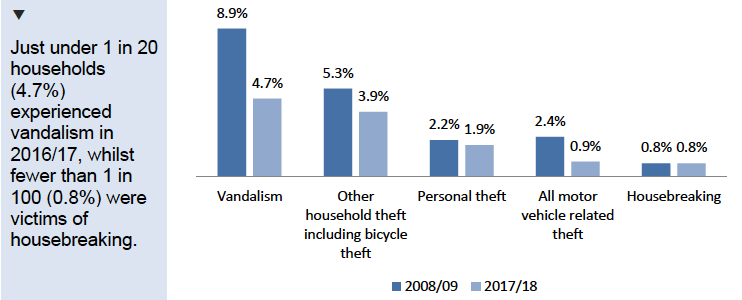
Note: Prevalence rates for vandalism, other household theft, motor vehicle related theft and housebreaking are presented as proportions of households experiencing each crime type.
Base: SCJS 2008/09 (16,000); 2017/18 (5,480). Variables: PREVVAND; PREVOTHERHOUSETHEFTCYCLE; PREVPERSTHEFT; PREVALLMVTHEFT; PREVHOUSEBREAK.
How did experiences of property crime vary across the population?
Those under 60, people in the most deprived areas of Scotland and those living in urban locations were more likely to experience property crime in 2017/18.
The SCJS also enables us to examine how experiences of property crime in 2017/18 varied across the population according to demographic and area characteristics. For example, as shown in Figure 4.5, the likelihood of being a victim of property crime in 2017/18:
- Was lowest for those aged 60 and over – with no differences detected amongst different categories of younger adults;
- Was greater for those living in the 15% most deprived areas in Scotland; and
- Was greater for adults living in urban locations.
Similar to violent crime, the likelihood of experiencing property crime in 2017/18 did not vary according to gender, with males and females found to have very similar prevalence rates (10.9% and 10.7% respectively)[41]. However, unlike violent crime, this finding is not a new development as property crime victimisation rates have tended to be fairly similar amongst males and females over the years.
Figure 4.5: Proportion of adults experiencing property crime, by demographic and area characteristics
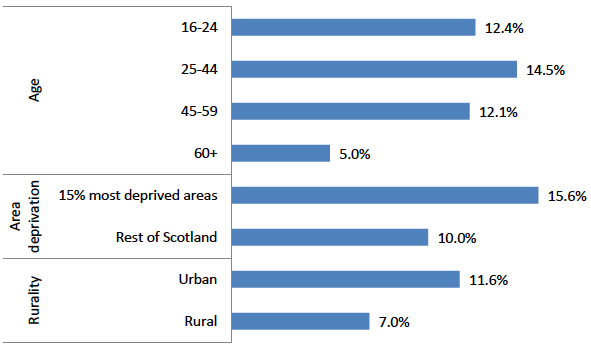
Base: 2017/18 (5,480). Variable: PREVPROPERTY, QDAGE, SIMD_TOP, URBRUR.
Although some inequalities remain, the likelihood of experiencing property crime has fallen for many groups since 2008/09.
Looking at trends over time reveals that the prevalence of property crime victimisation has decreased significantly since 2008/09 across many key groups in the population - including both males and females; all age groups; those living in the most deprived areas as well as those living elsewhere in Scotland; and adults in both urban and rural locations[42]. For example, the proportion of those aged 16-24 experiencing property crime has more than halved in the past decade, falling from more than one-in-four (26.1%) to around one-in-eight (12.4%).
The SCJS detected no change in the prevalence rates for any of the above population groups between 2016/17 and 2017/18.
What can the SCJS tell us about repeat victimisation?
As outlined previously, the SCJS estimates that the majority of adults did not experience any crime in 2017/18 and 10.8% of the population were victims of at least one property crime. However, the survey also enables us to further explore how experiences varied amongst victims and examine the concentration of crime, including what proportion of victims experienced a particular type of crime more than once during the year[43]. This is known as ‘repeat victimisation’.
Further information about the approach taken to process and derive SCJS results, including on repeat victimisation, is provided in the Technical Report.
2.6% of adults experienced two or more property crimes in 2017/18, accounting for around half of all property crime.
Looking at the volume of crime experienced by individual victims in more detail shows that 8.2% of adults were victims of one property crime only, therefore 2.6% were repeat victims of property crime.
Table 4.3 highlights the extent of different levels of repeat property victimisation, and the proportion of property crime accounted for by each group. For instance, around half of all property crime in Scotland in 2017/18 (49%) was experienced by 2.6% of the population who were repeat victims. On average, this group is estimated to have experienced 1.8 property crimes each over the year.
Table 4.3: Proportion of property crime experienced by repeat victims, by number of crimes experienced
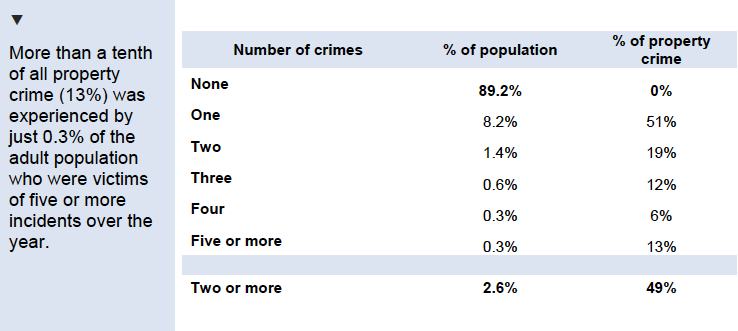
Base: SCJS 2017/18 (5,480). Variable: PREVPROPERTY, INCPROPERTY.
The likelihood of experiencing repeat victimisation has fallen since 2008/09.
Figure 4.6 displays trends in single and repeat property crime victimisation over time. It shows that between 2008/09 and 2017/18 there were decreases in the proportion of adults experiencing:
- single incidents of property crime – from 11.6% to 8.2%;
- repeat victimisation (two or more incidents of property crime) – from 6.4% to 2.6%; and
- high frequency repeat victimisation (five or more incidents of property crime) – from 0.9% to 0.3%.
The fall in the various levels of victimisation since 2008/09 have occurred in line with a decrease in the overall property crime victimisation rate[44] over the same period, as discussed previously.
Figure 4.6: Proportion of adults experiencing number of property crimes
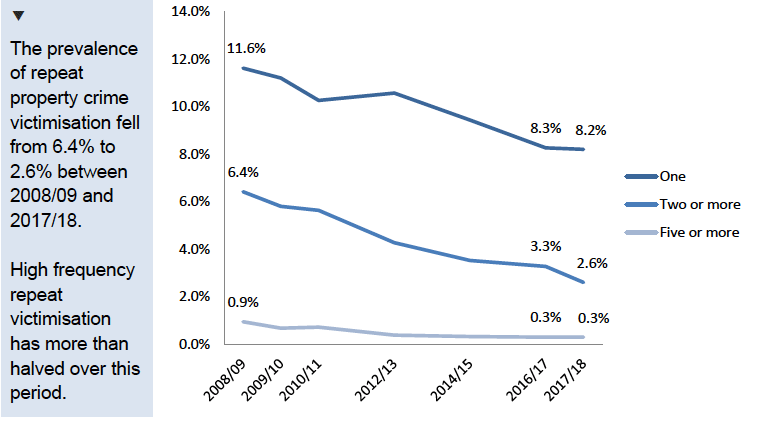
Base: SCJS 2008/09 (16,000); 2009/10 (16,040); 2010/11 (13,010); 2012/13 (12,050); 2014/15 (11,470); 2016/17 (5,570); 2017/18 (5,480). Variable: INCSURVEYCRIME, PREVSURVEYCRIME
Since the last SCJS in 2016/17, there has been no change in the level of single, repeat or high frequency repeat property crime victimisation – any apparent falls shown in Figure 4.6 are not statistically significant.
What do we know about the characteristics of property crime?
Most property crime incidents occurred in or near the home of the victim.
Consistent with previous years, the majority of property crime incidents in 2017/18 (67%) took place in and around the victim’s home. The most common specific location was immediately outside the respondent’s home[45] representing around half of all property crime in 2017/18 (51%).
Figure 4.7: Where property crime occurred in 2017/18
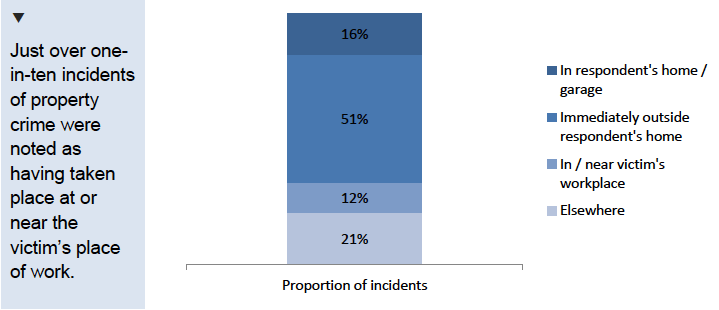
Base sizes: Property crime incidents (640); Variable: QWH1 / QWH3 / QWH5 / QWH7
The majority of property crime incidents took place on weekdays.
Where respondents provided details about when an incident occurred[46], around two-thirds of all property crimes in 2017/18 (68%) were said to have taken place during the week, with 32% occuring at weekends[47]. Incidence per day was therefore relatively similar across the week.
What do we know about the perpetrators of property crime?
Victims were unable to provide any details about the offender(s) in most instances.
Compared to violent crime incidents, victims of property crime are generally much less likely to report being able to say something about the offender in their experience. Respondents were able to provide any relevant information for just one-third of incidents (34%) in 2017/18.
As such, the section below presents a high-level summary of the sort of information provided by victims, although these findings should be interpreted with caution as they are not necessarily representative of all property crime incidents. This is particularly the case if comparing with findings from previous years[48]. Further results are available in the supporting data tables.
Where respondents were able to say something about the person or people who carried out the offence, victims noted that property crimes in 2017/18:
- Were mostly committed by males.
71% of incidents involved male offenders only. - Most commonly involved offenders under the age of 40.
Whilst property crimes were committed by people from a range of age categories, only 21% of incidents were noted as having involved offenders aged 40 or over. - Often involved perpetrators known by the victims.
Most incidents (55%) were committed by offenders who the victims knew or had seen before. Where offenders were known by the victim, just over two-fifths of incidents (44%) were said to have involved people ‘known well’.
Similarly, victims said that someone saw or heard what was going on or had some form of contact with the offender in about a quarter (26%) of property crime incidents. These respondents were asked additional questions about their experience, including the presence of weapons. 13% of such incidents[49] in 2017/18 were said to have involved perpetrators who possessed weapons.
What was the impact of property crime?
Direct financial costs resulting from property crime were typically of relatively lower value – but the impact of such costs will vary for each victim.
Victims of property crime where something was stolen (53% of property crimes) were asked to provide the approximate value of the items concerned. As Figure 4.8 shows, in more than three-fifths of incidents (61%) where victim were able to provide an estimate, the total value of items stolen was £100 or less. The total value was over £500 in just over one-in-ten incidents.
Figure 4.8: Financial impact of property crime where respondents could estimate cost
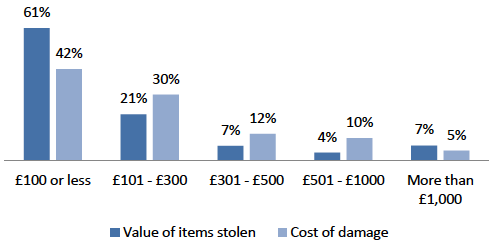
Base: Property crime incidents where something was stolen (320) or damaged (220); Variables: QSVAB; QDVAB. Excludes those who said don’t know to value of items lost or cost of damage.
Considering incidents where property was damaged (48% of property incidents), where victims were able to provide an estimate, victims said the total cost of the damage was £100 or less in 42% of incidents. Looking at instances of more costly damage, 15% of incidents led to damages totalling more than £500.
The most frequent emotional responses to experiences of property crime were annoyance and anger.
Consistent with previous years, victims of property crime most commonly reported being annoyed or angered by their experience (in 69% and 58% of incidents respectively).
What proportion of property crime was reported to the police?
Although most instances of property crime in 2017/18 were considered by victims to be criminal incidents, as in previous years only one-third of cases were reported to the police.
Victims of property crime described their experience as ‘a crime’ in almost three-quarters of incidents (73%), with 14% of incidents said to be ‘wrong but not a crime’ and 12% viewed as ‘just something that happens’. Property crime incidents were more likely to be viewed as criminal by the victims compared to experiences of violent crime in 2017/18 (of which 51% of incidents were considered to be ‘a crime’).
However, the SCJS estimates that only around one in every three property crimes (34%) were reported to the police in 2017/18. The reporting rate for property crime has shown no change since 2008/09, as depicted in Figure 4.9, and was not significantly different from the reporting rate for violent crime in 2017/18 (39%).
Figure 4.9: Proportion of property crime incidents reported to the police
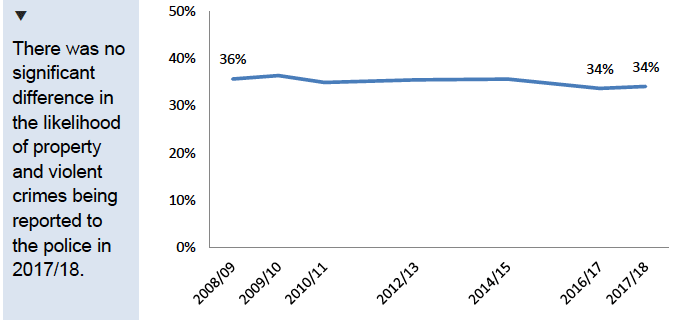
Base: Property crime incidents (640); Variable: QPOL
Incidents were more likely to be reported if any damaged or stolen goods were insured (45%), compared to a little over a quarter of cases (27%) where items were not covered.
Victims often considered incidents to be too trivial to report to the police.
As in previous years, the most common reason given by victims for not reporting their experience to the police was that the incident was perceived to be too trivial or not worth reporting (44% of incidents). Other commonly cited reasons for not reporting incidents included that the police could not have done anything (29%) and the victim believing the police would not have been interested (18%).
Where crimes were brought to the attention of the police, victims received information or assistance about the investigation and the case (where relevant) from the police in relation to half of all incidents (49%). Information or assistance was provided by the Witness Service/Victim Support Scotland in 14% of such cases, whilst in a quarter of incidents (24%) victims said they did not receive information or assistance from any organisation.
What consequences did victims believe property crime offenders should have faced?
Victims believed the majority of cases should have prosecuted in court, although prison sentences were not considered appropriate in most incidents.
Regardless of whether their experience was reported to the police, victims in three-fifths of all incidents of property crime in 2017/18 (60%) thought the offender should have been prosecuted in court. This is significantly higher than the equivalent figure for violent crime in 2017/18 where victims thought prosecution in court was appropriate in 39% of incidents.
Where victims thought an incident should have resulted in a court prosecution, a prison sentence was only considered a suitable outcome in relation to one in every five cases (20%).
Respondents who did not think property crime offenders should have been prosecuted in court (and those who were not sure) were asked about alternatives to prosecution and whether any other course of action should have taken place. The most frequent responses provided by victims were that offenders:
- should have apologised for their actions (cited in relation to 27% of such incidents);
- should have been given some kind of warning (23%); and
- should have been made to pay the victim(s) compensation (18% of incidents).
Notably, victims said that ‘nothing should have happened’ in relation to only 5% of these property crime incidents (i.e. where they did not think the offender should have been prosecuted in court). This compares to 22% of violent incidents (where prosecution in court was deemed unnecessary by victims), again adding to the notion that those who experienced property crime were generally more likely to believe perpetrators should have faced some sort of consequences.
Contact
Email: scjs@gov.scot
There is a problem
Thanks for your feedback